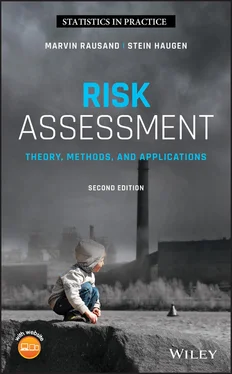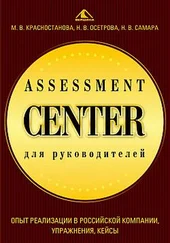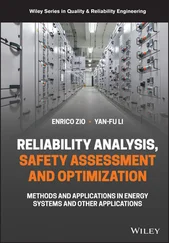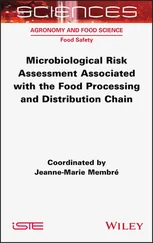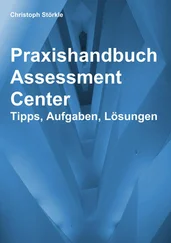Information is provided about the uncertainty associated with the results and the sensitivity of the results with respect to changes in assumptions, data, and modeling principles and methods.
Chapter 6presents several ways of expressing risk and reporting is discussed in more detail in Section 3.3.
3.2.6.2 Step 6.2: Present Results
In many cases, it is beneficial to present the results from the risk assessment in other ways than just through a report. This can be done in different ways, through brochures, popularized versions of the report, or by presentations. This needs to be considered depending on the stakeholders and the importance of the decisions that the risk assessment supports.
3.3 Risk Assessment Report
The risk assessment is usually presented in a report, but may also be accompanied by brochures, slide presentations, and videos. To be useful as a decision basis, the decision‐makers must be able to understand the conclusions and recommendations made by the study team. The information from the risk assessment must, therefore, be presented as clearly and concisely as possible.
The decisions to be made are often important and far‐reaching. It is, therefore, important that the decision‐makers can have confidence in all the findings made by the study team. The risk assessment reports must be well founded and trustworthy, and it must be possible to review and verify all the results. All conclusions and recommendations must be traceable to documents describing the background, models, input data, calculations, and so on.
The complexity of a risk assessment, and probabilistic methods in particular, may pose a significant barrier to understanding the report. It is, therefore, important that the main results be described clearly and documented in a language that decision‐makers and other stakeholders understand.
The level of detail in the report(s) should correspond to the risk level. A study object with a low level of risk typically requires a less extensive report than that for a study object with a very high level of risk.
How the report is written and the level of detail depends on the objectives of the study and for whom the report is intended, e.g.
1 The report will only be used as a decision basis for the line management, and no external parties are expected to get access to the report.
2 The report will be used by the company management to establish good risk management practices. Thus, the results of the risk assessment can be used to help define the requirements for various elements of the facility safety program, including maintenance, training, operating procedures, safety inspections and audits, and management of change.
3 The report will be presented to the board of directors as a background for strategic discussions.
4 The report will be made public. This is, for example, required for companies that have to fulfill the requirements of the EU Seveso III directive (EU 2012).
5 The results and the report will be presented at public meetings with stakeholders.
Some laws and regulations have special requirements to the format of the risk assessment report. This applies, for example, to the Seveso III directive.
3.3.1 Contents of the Report
A possible structure of a risk assessment report is presented subsequently. It is recommended that too much narrative text be avoided and that important points be enumerated for referential purposes.
In cases where the risk assessment has to be updated regularly, the initial and all subsequent revision numbers should be recorded on the report's title page. The title page should show the date of the latest revision, the revision number, and be signed (e.g. see U.S. DOE 2004).
A disclaimer is sometimes included in the report. The purpose is to describe the limits of the legal claims that can be filed against the organization responsible for preparing the report.
3.3.1.3 Executive Summary
The main results should be listed, together with recommendations for risk reduction measures and further actions. When the report is updated, the revision number and who has performed the assessment should be noted.
Introduction (including why the risk assessment is executed).
Objectives and limitations.
Analysis approach.
Main conclusions and recommendations (each conclusion or recommendation should be briefly justified).
The executive summary should provide an overview of the background, assumptions, objectives, scope, results, and conclusions at a level that is useful to a wide audience of safety specialists and at the same time is adequate for high‐level review.
3.3.1.4 Document References
All the documents and other information sources used in the risk assessment should be listed, together with proper references.
3.3.1.5 Acronyms and Glossary
Special terms or concepts that are used in the study should be listed and defined and/or explained.
The name, position, competence, and role of each member of the study team should be listed.
The introduction should describe the background for the study, the objectives, and the assumptions, together with a clear and concise tabulation of all known limitations and constraints associated with the risk assessment. Incidents and accidents that have taken place in similar systems should be listed.
The time interval during which the risk assessment was performed should also be recorded.
3.3.1.8 Description of the Study Object
The study object is described briefly together with its main functions. References to more detailed descriptions should be given. Conditions and limitations for operation of the study object should also be mentioned, for example, owners, responsibilities, location, staffing level, and important stakeholders (e.g. customers, passengers).
The description should contain sufficient information to verify that the study object is consistent with the assumptions made in the risk assessment.
3.3.1.9 Analysis Approach
This part of the report should give an overview of the analytical methods that have been used, for example, FMECA and HAZOP (see Chapter 10). In general, arguments for the choice of method should also be given.
3.3.1.10 Risk Acceptance Criteria
Acceptance criteria are important for evaluating the risk and should, therefore, be listed in the report. If risk matrices are used, the frequency and severity classification should be defined.
3.3.1.11 Hazards and Hazardous Events
Hazards, threats, and hazardous events that have been identified should be listed in this part: for example, in the format of a table. In some cases, it may be relevant to give a more detailed description of the most important hazardous events.
The models, methods, and tools that are used in the risk assessment should be described, together with possible limitations of these in relation to the assessment.
3.3.1.13 Data and Data Sources
It is important to list and describe the information that is used such that the risk assessment can be verified by a third party. The data used should, as far as possible, be documented in a data dossier (see Chapter 9). A review of previous accidents and near‐accidents in similar applications should be part of this chapter.
3.3.1.14 Frequency and Consequence Analysis
Читать дальше
